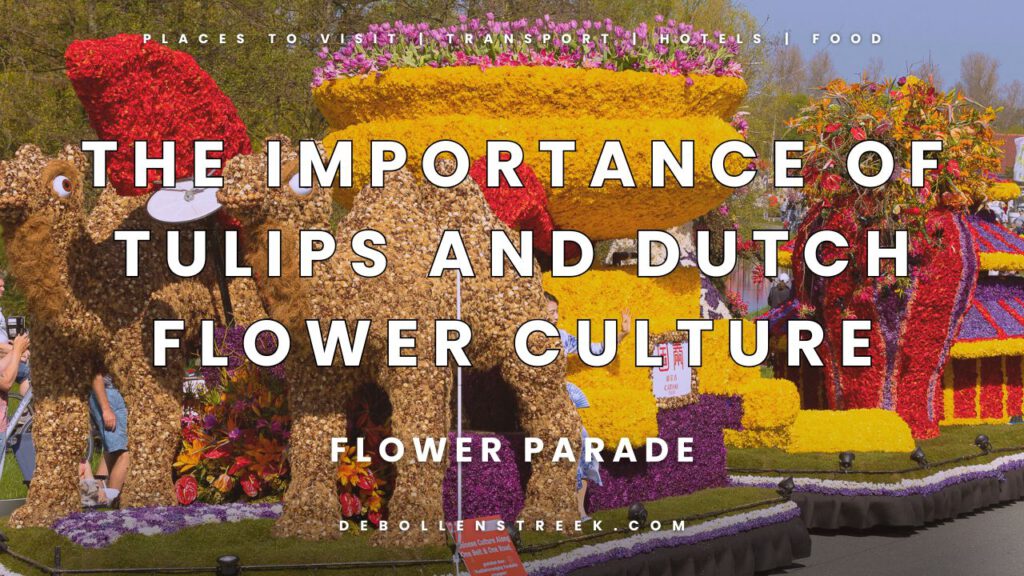
Introduction to Importance of Tulips and Dutch Flower Culture
Today we talk about the Importance of Tulips and Dutch Flower Culture. As you might know, Tulips are more than flowers in the Netherlands—they are a global symbol of Dutch culture. These vibrant blooms have shaped the nation’s history and economy while elevating its reputation in floriculture. Their influence extends far beyond gardens, making them an enduring emblem of Dutch heritage.
This article explores the historical, economic, and cultural importance of tulips and Dutch flower culture. From their arrival in the 16th century to their role in modern tourism, tulips have left a profound mark on the Netherlands. Let’s uncover their fascinating story and the traditions they inspire.
The Historical Significance of Tulips in Dutch Culture
Tulips hold a special place in Dutch culture, rooted in centuries of history and tradition. Their journey from a rare import to a cornerstone of the Netherlands’ identity is a fascinating tale of innovation, artistry, and economic impact.
The Arrival of Tulips in the Netherlands
Tulips first arrived in the Netherlands during the 16th century, brought from Turkey. These exotic blooms captivated botanists and collectors alike. Among them, Carolus Clusius, a renowned botanist, played a pivotal role. He introduced tulips to Dutch soil by planting the first bulbs in the Hortus Botanicus at Leiden University. His work laid the foundation for tulip cultivation, sparking an interest that would grow into a national passion.
Tulip Mania: The First Economic Bubble
During the 17th century, tulips became symbols of wealth and prestige. This fascination led to Tulip Mania, one of the world’s first recorded economic bubbles. Rare varieties, such as the Semper Augustus, commanded exorbitant prices, with single bulbs selling for more than a house. However, the frenzy eventually collapsed, leaving many investors in financial ruin. Despite this, Tulip Mania cemented tulips’ place in Dutch history as both an object of desire and a cautionary tale.
Development of the Dutch Tulip Industry
The Netherlands transformed tulips from luxury items into a thriving industry. By the 18th century, regions like the Bollenstreek became hubs for tulip cultivation. Farmers adopted advanced agricultural methods, including greenhouse technologies, to improve production. Today, tulips are not only a symbol of beauty but also a testament to the Netherlands’ innovation in horticulture.
Tulips as a National Symbol
Tulips have become deeply intertwined with Dutch identity, symbolizing the nation’s cultural richness and remarkable horticultural achievements. Not only do they captivate with their beauty, but they also carry profound symbolic meaning that has endured for generations.
Icon of Dutch Identity
Tulips are celebrated across the globe as a reflection of the Netherlands’ horticultural prowess. Moreover, during the Golden Age, these flowers prominently appeared in Dutch art, especially in still-life paintings. For instance, artists like Jan Brueghel the Elder showcased their vibrant hues and intricate forms, emphasizing their universal appeal. Even today, tulips continue to serve as a proud emblem of Dutch culture, representing not only innovation but also beauty and heritage.
Symbol of Renewal and Spring
As one of the first flowers to bloom in spring, tulips symbolize renewal and the arrival of brighter days. Consequently, their seasonal appearance signals the end of winter and ushers in the warmth of springtime. This strong association with rebirth makes tulips an essential feature of Dutch spring festivals and celebrations. Whether adorning local gardens or showcased at major events, tulips bring undeniable joy and inspire awe, perfectly capturing the essence of the season.
Economic The Importance of Tulips and Dutch Flower Culture
Tulips are not only a vibrant symbol of Dutch heritage but also a cornerstone of the country’s economy. They highlight the importance of tulips and Dutch flower culture while driving significant contributions to global trade, tourism, and local industries.
The Global Tulip Market
The Netherlands leads the world in tulip production, cultivating over 3 billion tulip bulbs every year. This incredible scale underscores the importance of tulips in Dutch flower culture and their role in sustaining the global tulip market. Regions like the Bollenstreek and Noordoostpolder are at the heart of this industry, producing high-quality bulbs that meet international demand. Additionally, these tulip-growing regions utilize advanced agricultural techniques, including greenhouse innovations, to maintain their competitive edge. The country’s reputation as a global leader in floriculture is strengthened further by exporting millions of tulip bulbs annually, showcasing the importance of tulips to the Dutch economy.
Impact on Local Economies
Tulip farming and Dutch flower culture generate thousands of jobs, providing steady employment across various sectors. These include agriculture, logistics, and floriculture technology. Tourism tied to tulip events, such as Keukenhof and the Flower Parade, boosts revenue for local businesses each spring. Hotels, cafes, and transportation services thrive during this period, illustrating how the importance of tulips extends well beyond farming. Moreover, events celebrating tulips and Dutch flower culture draw millions of visitors, reinforcing their essential role in local economies. This financial impact highlights how tulips and flower-related activities contribute to the prosperity of communities across the Netherlands.
Cultural Celebrations and Tourism in Dutch Flower Culture
Tulips play a vital role in Dutch flower culture, and their impact extends far beyond the agricultural and economic sectors. They are at the heart of numerous cultural celebrations and tourism-driven events. These celebrations draw visitors from all over the world, showcasing the beauty and significance of tulips while contributing significantly to Dutch tourism.
Major Flower Festivals Featuring Tulips
One of the most notable celebrations of tulips is the Keukenhof Gardens, often referred to as the “Garden of Europe.” Located in Lisse, it is the largest flower garden in the world, with over 7 million flowers on display each year, many of which are tulips. This iconic event highlights the importance of tulips and Dutch flower culture. It attracts over 1.5 million visitors annually, making it a central piece of Dutch tourism.
Additionally, Amsterdam’s annual Tulip Festival is another important event that showcases tulips in full bloom across the city. Thousands of tulips brighten the streets, parks, and squares, reflecting the nation’s pride in its floral heritage. Events like these draw visitors, eager to experience the vivid displays, and celebrate the rich cultural traditions associated with tulips.
The Bloemencorso Bollenstreek, or Flower Parade, is also an integral part of tulip celebrations in the Netherlands. This spectacular event features floats adorned with tulips and other flowers, making it a stunning tribute to Dutch floriculture. It provides a perfect opportunity for people to witness the beauty and cultural significance of tulips firsthand. The parade also reinforces the link between Dutch identity and tulip cultivation, drawing tourists from all over the globe.
The Tourism Impact of Flower Culture
Tulips are not just celebrated at flower festivals—they are a major driver of Dutch tourism. Events such as Keukenhof Gardens, the Amsterdam Tulip Festival, and the Flower Parade bring millions of visitors each year. In fact, Keukenhof alone contributes significantly to the Dutch economy, attracting tourists from more than 100 countries. This surge in tourism underscores the importance of tulips and Dutch flower culture in promoting the Netherlands as a key destination for springtime visitors.
Moreover, tulip-related tourism contributes to local businesses and services. Hotels, restaurants, and local shops benefit from the influx of flower enthusiasts. Even transportation services see a boost as tourists flock to the Netherlands to experience the breathtaking tulip displays.
Tulips as a Diplomatic and Marketing Tool
Tulips also serve as a powerful tool in Dutch cultural diplomacy. The Dutch government often gifts tulips to foreign countries as a gesture of goodwill, promoting the country’s horticultural expertise and fostering international relationships. These gestures enhance the Netherlands’ global image and reinforce its position as the world’s leader in tulip cultivation.
Additionally, tulips are a key marketing tool. The Netherlands uses its tulip heritage to promote the country as a vibrant, innovative destination. International media and social platforms, especially Instagram, play a vital role in spreading the beauty of Dutch tulips, attracting even more visitors each year.
Challenges and Future of Dutch Tulip Cultivation
While tulips are a global symbol of Dutch flower culture, their cultivation faces numerous challenges. However, the industry is also adapting with innovative solutions to maintain its prominence in the global market. Let’s explore the obstacles and advancements shaping the future of tulip cultivation.
Modern Challenges
One of the biggest issues facing the tulip industry is climate change, which affects the growing conditions for tulips. Rising temperatures and unpredictable weather patterns have made it increasingly difficult to maintain consistent yields. Tulip farmers must also contend with stricter agricultural legislation, which limits land availability and regulates chemical use.
Another challenge is the threat of pests and pathogens. Tulips are particularly susceptible to diseases like tulip fire and pests that can damage crops. Combating these issues often requires significant investment in research and sustainable practices.
In addition, the high cost of land in traditional growing regions, such as the Bollenstreek, puts pressure on tulip farmers. Many are forced to expand into new areas, such as the Noordoostpolder, where land is more affordable but presents its own set of environmental challenges.
Innovations in the Tulip Industry
Despite these challenges, the Dutch tulip industry continues to innovate. Advances in breeding techniques have led to the development of tulip varieties that are more resistant to diseases and adverse weather conditions. These innovations help ensure the long-term viability of tulip farming.
Another significant development is the shift toward sustainable cultivation practices. Farmers are increasingly using environmentally friendly methods, such as natural pest control and biodegradable materials, to reduce their environmental impact. This focus on sustainability aligns with global trends and enhances the Netherlands’ reputation as a leader in responsible floriculture.
The integration of technology has also revolutionized tulip cultivation. Automation in planting, harvesting, and sorting processes has improved efficiency and reduced labor costs. Additionally, data-driven farming practices, such as using sensors to monitor soil health and water usage, enable farmers to optimize their yields while minimizing waste.
So much more Flower Parade
There’s so much more to explore about the Flower Parade and its incredible traditions! From learning about the types of flowers and float construction in the Flower Parade to uncovering all the details about Flower Parade tickets and pricing, there’s something fascinating waiting for you. Dive into the vibrant world of flower festivals and events around the Flower Parade or discover the best insider advice with our guide on tips for attending the Flower Parade. Don’t forget to check out the Flower Parade route and best viewing spots, so you can secure an unforgettable experience at this iconic event.
Ready to immerse yourself in the colorful magic of the Flower Parade? Start your journey with our comprehensive guide to Bloemencorso: A Guide to the Netherlands’ Flower Parades and get all the details you need with Flower Parade2025 – Everything You Need to Know.
Importance of Tulips and Dutch Flower Culture | Conclusion
Tulips are more than just beautiful flowers—they are a cornerstone of Dutch flower culture, deeply rooted in the history, economy, and traditions of the Netherlands. From their introduction in the 16th century to their role in the economic and cultural development of the nation, tulips have shaped Dutch identity and become a symbol of renewal and natural beauty.
The economic significance of tulips cannot be overstated. The Netherlands leads the global market in tulip cultivation and exports, contributing billions to its economy. Moreover, events like the Keukenhof Gardens, the Flower Parade, and tulip festivals attract millions of tourists each year, highlighting the strong connection between Dutch flower culture and international tourism.
As the tulip industry faces modern challenges, such as climate change and land scarcity, Dutch innovation continues to pave the way for sustainable solutions. Advances in breeding, technology, and environmentally friendly farming practices ensure that tulips remain an enduring symbol of Dutch resilience and creativity.
Whether through vibrant festivals, picturesque fields, or cultural diplomacy, tulips represent the enduring legacy and bright future of Dutch flower culture. By exploring the rich history and ongoing evolution of tulip cultivation, visitors and enthusiasts alike can gain a deeper appreciation for the flower’s lasting impact.
Don’t miss out on key event updates—check our Agenda for the latest happenings and timings. Want to dive deeper into the Bollenstreek? Our Comprehensive Guide to Bollenstreek is packed with insider tips and must-see spots. Looking for fun things to do? Browse our Activities and helpful Information sections to make the most of your adventure. And before you leave, be sure to visit Souvenir Shop Holland for unforgettable keepsakes that capture the heart of the region.



